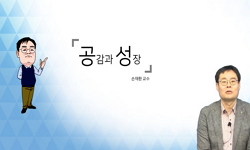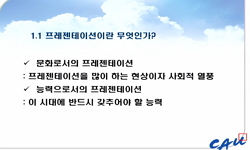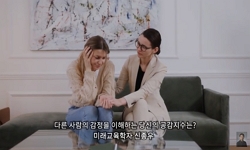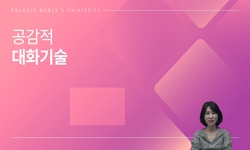Purpose: This study aims to analyze the conversational functions of reflecting utterances of doctors during medical interviews. Methods: The data consists of doctor-patient conversations during 50 medical interviews which were recorded and transcribed...
http://chineseinput.net/에서 pinyin(병음)방식으로 중국어를 변환할 수 있습니다.
변환된 중국어를 복사하여 사용하시면 됩니다.
- 中文 을 입력하시려면 zhongwen을 입력하시고 space를누르시면됩니다.
- 北京 을 입력하시려면 beijing을 입력하시고 space를 누르시면 됩니다.

문진에서 의사의 ‘반사 발화’의 대화기능 = Conversational Functions of Doctors' Reflecting Utterances During Medical Interviews
한글로보기부가정보
다국어 초록 (Multilingual Abstract)
Purpose: This study aims to analyze the conversational functions of reflecting utterances of doctors during medical interviews.
Methods: The data consists of doctor-patient conversations during 50 medical interviews which were recorded and transcribed. Each reflecting utterance of the doctors was assigned to an informational function according to its contribution in gathering important information. The empathic aspect was also taken into account.
Results: As for the information dimension, 8 information accommodating functions were revealed: reflecting utterances were commonly a request for confirmation of some relevant information through selecting, supplementing, summarizing, disambiguating, paraphrasing, expanding, specifying, and completing the received information. A couple of functions such as expression of surprise, empathy, and personal concern were identified at the relational dimension.
Conclusion: Because the doctor continuously attempts to obtain more information regarding the symptoms of the patient during the medical interview, the maximally efficient exchange of information must be the ultimate goal pursued in doctor-patient conversation. The frequent appearance of reflecting utterances can be explained from this perspective. It can be also suggested that the reflecting utterances could contribute to the management of interpersonal relationships as they give the impression of personal involvement.
참고문헌 (Reference)
1 우상수, "의사와 환자의 대화" 백산서당 2008
2 Thomas Spranz-Fogasy, "의사-환자의 대화행위 구조 분석" 대한의료커뮤니케이션학회 3 (3): 39-47, 2008
3 Recanati F, "The pragmatics of what is said" 4 : 295-329, 1989
4 Shin HC, "The Impact of Physician Behaviors on Patient Satisfaction" 15 : 1157-1170, 1994
5 Grice HP, "Syntax and Semantics. Vol. 3" Academic Press 41-58, 1975
6 Park SC, "On the communicative role and significance of the ‘Phatic Communion’" 20 : 79-113, 2006
7 Carston R, "Mental Representations:The Interface between Language and Reality" 155-181, 1988
8 Watzlawick P, "Menschliche Kommunikation" Hans Huber 2011
9 Bak Yong Ik, "Hwanja jungsimui uilyo keomyunikeisyeon (Patient Centered Health Communication)" Baeksanseodang 2010
10 Geisler L, "Arzt und Patient-Begenung im Gespräch -Wirklichkeit und Wege" Pharma 2002
1 우상수, "의사와 환자의 대화" 백산서당 2008
2 Thomas Spranz-Fogasy, "의사-환자의 대화행위 구조 분석" 대한의료커뮤니케이션학회 3 (3): 39-47, 2008
3 Recanati F, "The pragmatics of what is said" 4 : 295-329, 1989
4 Shin HC, "The Impact of Physician Behaviors on Patient Satisfaction" 15 : 1157-1170, 1994
5 Grice HP, "Syntax and Semantics. Vol. 3" Academic Press 41-58, 1975
6 Park SC, "On the communicative role and significance of the ‘Phatic Communion’" 20 : 79-113, 2006
7 Carston R, "Mental Representations:The Interface between Language and Reality" 155-181, 1988
8 Watzlawick P, "Menschliche Kommunikation" Hans Huber 2011
9 Bak Yong Ik, "Hwanja jungsimui uilyo keomyunikeisyeon (Patient Centered Health Communication)" Baeksanseodang 2010
10 Geisler L, "Arzt und Patient-Begenung im Gespräch -Wirklichkeit und Wege" Pharma 2002
동일학술지(권/호) 다른 논문
-
- 대한의료커뮤니케이션학회
- 김지현
- 2014
- KCI등재후보
-
의학저널리즘의 의료커뮤니케이션적 기능과 역할, 향후 과제
- 대한의료커뮤니케이션학회
- 김용
- 2014
- KCI등재후보
-
A Preliminary Analysis of History-Taking Questions in Korean Primary Care Contexts
- 대한의료커뮤니케이션학회
- 박유정
- 2014
- KCI등재후보
-
- 대한의료커뮤니케이션학회
- 윤석희
- 2014
- KCI등재후보
분석정보
인용정보 인용지수 설명보기
학술지 이력
| 연월일 | 이력구분 | 이력상세 | 등재구분 |
|---|---|---|---|
| 2024 | 평가예정 | 재인증평가 신청대상 (재인증) | |
| 2021-01-01 | 평가 | 등재학술지 선정 (계속평가) |  |
| 2019-01-01 | 평가 | 등재후보학술지 선정 (신규평가) |  |
| 2018-12-01 | 평가 | 등재후보 탈락 (계속평가) | |
| 2017-01-01 | 평가 | 등재후보학술지 유지 (계속평가) |  |
| 2016-01-01 | 평가 | 등재후보학술지 유지 (계속평가) |  |
| 2015-01-01 | 평가 | 등재후보학술지 유지 (계속평가) |  |
| 2013-01-01 | 평가 | 등재후보 1차 FAIL (등재후보1차) |  |
| 2012-01-01 | 평가 | 등재후보학술지 유지 (기타) |  |
| 2010-01-01 | 평가 | 등재후보학술지 선정 (신규평가) |  |
| 2006-12-12 | 학회명변경 | 영문명 : Korean Health Communication Society -> Korean Academy on Communication in Healthcare |
학술지 인용정보
| 기준연도 | WOS-KCI 통합IF(2년) | KCIF(2년) | KCIF(3년) |
|---|---|---|---|
| 2016 | 0.44 | 0.44 | 0.44 |
| KCIF(4년) | KCIF(5년) | 중심성지수(3년) | 즉시성지수 |
| 0.52 | 0.53 | 0.796 | 0.23 |





 KCI
KCI KISS
KISS






